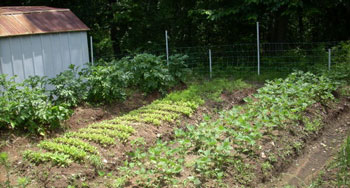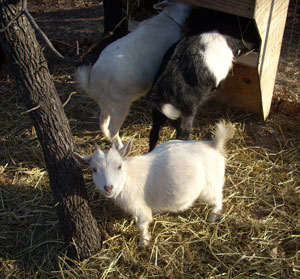It’s Jam Band Friday – http://www.youtube.com/watch?v=xmuIkJtL42g
It really is something that some people suggest you do.
http://news.bbc.co.uk/2/hi/uk_news/england/cambridgeshire/8357134.stm
Pee to help make your garden grow

The “pee bale” is only in use out of visitor hours |
Gardeners at a National Trust property in Cambridgeshire are urging people to relieve themselves outdoors to help gardens grow greener.
A three-metre long “pee bale” has been installed at Wimpole Hall.
Head gardener Philip Whaites is urging his male colleagues to pee on the straw bale to activate the composting process on the estate’s compost heap.
He said the “pee bale” is only in use out of visitor hours, since “we don’t want to scare the public”.
He said: “For eight weeks now, male members of our garden and estate teams have been using the outdoor straw bale when nature calls.
“The pee bale is excellent matter to add to our compost heap to stimulate the composting process; and with over 400 acres of gardens and parkland to utilise compost, we need all the help we can get.
|
FROM THE TODAY PROGRAMME
|
“There are obvious logistical benefits to limiting it to male members of the team, but also male pee is preferable to women’s, as the male stuff is apparently less acidic.”
By the end of the year, it was calculated that the 10 men from the 70-strong garden and estates team will make more 1,000 individual trips to the pee bale, contributing towards the compost for the estate.
The estate said it will have saved up to 30% of its daily water use by not having to flush the loo so many times.
:}
( http://www.youtube.com/watch?v=12b-VH1yahE )
People like to talk about it too. GardenWeb a huge web site devoted to all things about gardening has a question and answer section. A person posted “To Pee Or Not To Pee” question and go hundreds of answers. I can not give you a true sense of the size of the post. You must go see it. But it was started on April 5th 2008 and stretttttched all the way to September 21, 2009! Some of the responses:
http://forums2.gardenweb.com/forums/load/soil/msg042142151191.html
|
|
clip this post email this post what is this? |
right, you’ve heard of the carbon to nitrogen ratio, i’m sure.
it’s controversial but most of the time it’s listed as 30 parts carbon to one part nitrogen.a lot of poeple do not make a big fuss about the proper ratio, they just mix until it heats up the way they like it.
why don’t you try mixing the grass clippings into a larger amount of shredded dead leaves, staw, or even sawdust.
As for the morals….you’re recycling, saving water, lightening septic stress, and helping your yard or garden out all in the same by using urine.
one word of advice…..if you make a hot compost pile out of urine, make sure your friend doesn’t try to touch it after you tell him about how warm the pile gets……(yes my friend came over and almost did, i was like whoa whoa!!!)
I pee in a bottle that I keep in a room which i have seedlings started in, and the next day i take it outside and pour it into the center of my pile, the thing i like about using pee is that you’re also helping to keep the pile moist as you add nitrogen, and it does work.
|
|
clip this post email this post what is this? |
- Posted by idaho_gardener 6a_sw_idaho (My Page) on
Sun, Apr 6, 08 at 2:05
| I keep a kitchen compost barrel outside the back door. It gets kitchen waste and shredded office paper. I give it a golden shower (at night when the wife is asleep) to keep it moist. Happily, the compost bin has no aroma at all. It seem that the office paper absorbs the moisture and puts it to work immediately.Today’s brainstorm; I have a 40 gal. tub sunk into the ground for the ducks to take a dip in. They ‘fertilize’ the water and algae starts to grow. It finally occurred to me that the algae makes an ideal ‘green’ for compost. |
|
RE: compost – to pee or not to pee |
clip this post email this post what is this? |
- Posted by sylviatexas z8a Tx (My Page) on
Sun, Apr 6, 08 at 17:23
| Agatha Christie said in her autobiography that her grandmother had the most beautiful roses in the neighborhood; she used the “nightwater” (this must have been in about the 1890’s, when people had chamber pots under the beds) on them! |
|
|
clip this post email this post what is this? |
- Posted by belgianpup Wa/Zone 8 (My Page) on
Sun, Apr 6, 08 at 23:42
| Unless you have something like a bladder infection or leptospirosis, urine tends to be sterile.For all the people who say “Eeeeewww!”, just keep in mind that septic and sewer systems are mostly ‘eyewash’. The fact that a couple of gallons of good clean drinking water are used to flush away half a cup of urine so it’s out of your sight and out of your mind isn’t exactly being environmentally responsible.All that nitrogen that is produce doesn’t just evaporate, you know. Like DDT, it all goes somewhere, either into the groundwater or into the ocean. Have you ever gone down to your favorite little creek and wondered where all that green algae came from? Have you passed by the marsh on your way to the ocean and it didn’t smell so great and had quite a lot of algae growing there? Between ‘modern’ farming methods and ‘modern’ waste dumping, we’re contaminating a lot of the world.Sue |
|
|
clip this post email this post what is this? |
| Urine specimens are not sterile. Moreover, even sterile urine will grow bacteria at room temperature. I have examined results of urine tests, thousands and thousands of them, in my professional life, for 30 years. I do this as part of my anesthesia evaluation prior to anesthetizing people for surgery.As I said above, the only way to obtain a sterile urine specimen is sterile catheterization of the bladder or clean catch technique. I doubt that most of you are following these techniques in obtaining urine for your compost or garden.Karen |
|
|
clip this post email this post what is this? |
| My old house was in the city. I’m positive that rats, and other animals got into the compost pile. Can I safely assume they have been exposed to E coli? Can I assume that my own urine is more sterile than the rats and other animals that dig, poop, and pee in the pile? You are at a greater risk of exposure every time you use a public restroom. How confident are you that the last person that touched the door knob, phone, elevator button properly washed their hands after going to the bathroom? What about the fridge at work? How many people touch it? How many of those people properly wash? Are you sure they didn’t touch your food? What about the water cooler? Did the last person that used it pick his nose before he held the water open? |
:}
( http://www.youtube.com/watch?v=Kn90uvj9Pgw&feature=related )
You think it is just weirdo gardeners? Think again…But “liquid gold” oh man come on.
http://www.homegrownevolution.com/2007/01/pee-on-your-compost.html
Tuesday, January 23, 2007
Pee on your Compost
 Judging from comments and our web statistics you people out there love discussing poo. So it’s about time that we move on to pee. Why waste your perfectly good urine? Indeed, both Ghandi and Jim Morrison drank their own urine for it’s reputed health benefits. But we ain’t gonna go there.
Judging from comments and our web statistics you people out there love discussing poo. So it’s about time that we move on to pee. Why waste your perfectly good urine? Indeed, both Ghandi and Jim Morrison drank their own urine for it’s reputed health benefits. But we ain’t gonna go there.
Our suggestion for the day is to save that piss for your plants. Urine is a fantastic source of nitrogen and it’s estimated that we all produce enough urine to fertilize all the wheat and corn that we as individuals consume. And urine is sterile and safe unless you’ve got a bladder infection.
Urine should be diluted before applying directly to plants since salts in your pee can build up in the soil. Dilution should be at least 10 parts water to one part urine. Peeing directly on plants can burn them as anyone who owns a dog already knows about. Urine is easiest to apply to non-food crops, though it’s perfectly safe to use on fruit trees and bushes. Applying it to root crops is more controversial, and frankly seems like a practice best left to hippies, so if you try this at least cease application at a respectable interval before harvesting.
There is even a book called Liquid Gold on the subject of pee as fertilizer and the ever more resourceful Europeans have developed a number of urine diverting flush toilets similar to the one we profiled earlier to take the labor out of urine saving.
:}
( http://www.youtube.com/watch?v=AW5_hqNcj74&feature=related )
I know, I know…I keep this post going because it is hysterical, I get to keep posting great Paul Butterfield tunes and because I can..Still everything good must come to end:
http://www.english-gardening.com/green_up_your_thumb/compost_3.htm
Q. I’ve heard that urinating on a compost heap helps, is this true, or is it a joke?
A. Urine contains nitrogen that will help feed the microbes and speed up their break-down of the brown carbon-rich material. Also, the water content will help keep the heap moist. I regularly pee on my compost heap – but only when no-ones looking.
:}
Everybody does it when no one is looking or at night…why not pee in a pitcher, keep it cold (and well labeled) in the fridge and just dump it when you have the time? HAHAHAHA
( http://www.youtube.com/watch?v=Nqa6tMwvgFA&feature=related )
:}

 Welcome to our free online resource for off-grid living.
Welcome to our free online resource for off-grid living.

 In the summer of 1980, my wife, three-month old son and I moved “off-grid”. We loved living in San Francisco but wanted to live a simpler, more independent lifestyle, and so we bought a small cabin with land on a rural island in the Pacific Northwest. Since there were no services to the island, our home had no electricity. Residents of the island had to create their own electricity or do without.
In the summer of 1980, my wife, three-month old son and I moved “off-grid”. We loved living in San Francisco but wanted to live a simpler, more independent lifestyle, and so we bought a small cabin with land on a rural island in the Pacific Northwest. Since there were no services to the island, our home had no electricity. Residents of the island had to create their own electricity or do without.


















